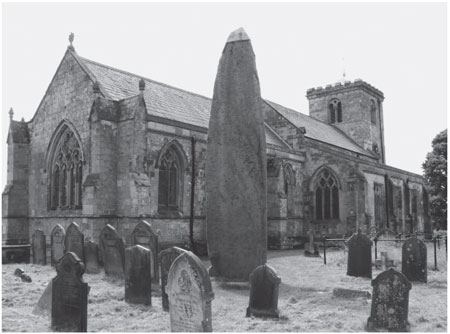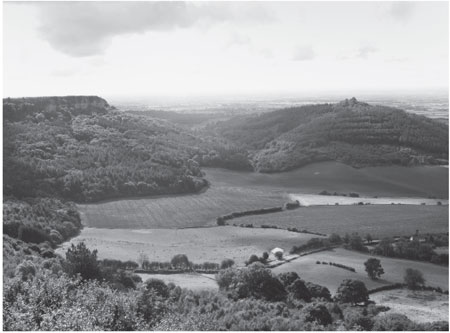Folklore of Yorkshire (14 page)
Read Folklore of Yorkshire Online
Authors: Kai Roberts

Examples of a larger topographic magnitude are also numerous. For instance, in the Colne and Holme Valleys, the barren and windswept summit of West Nab was considered to be the place where Satan had first set foot on earth. Meanwhile, sailors and fishermen along the Yorkshire coast regarded the rocky promontory of Filey Brigg – a dangerous impediment to shipping for centuries – as the ‘Devil’s creation’. Similarly, the natural amphitheatre known as the Hole of Horcum which once presented a laborious obstacle for travellers across the North York Moors, is colloquially named the ‘Devil’s Punchbowl’. Legend tells that it was scooped out by the Devil who meant to throw the earth at Scarborough. However, he was so startled by the sunlight glinting off Lilla Cross that he dropped the debris, which formed Blakey Topping.
The Hole of Horcum story exhibits another common motif in Devil lore: namely his almost comical stupidity and clumsiness. Whilst local legends often portray Satan working tirelessly against pious Christian towns, his schemes are invariably thwarted by his own ineptitude. Another such story is told of the Devil’s attempt to throw a vast boulder at the village of Hartforth, just north of Richmond. He plucked the rock from the vicinity of Gilling, lifted it high above his head and declared, ‘Have at thee, Black Harforth, but have a care of bonny Gilling!’ But, as is so often the case in these tales, he substantially overshot his mark and the stone came to rest far beyond Hartforth, on the north side of Gatherley Moor. Again, his claw marks are supposedly imprinted on its surface.

West Nab near Meltham, where the Devil first set foot on earth. (Kai Roberts)

The Devil’s Arrows at Boroughbridge, thrown by Satan himself. (Kai Roberts)
Yet another example of the motif is connected to the Devil’s Arrows, a row of three vast menhirs which lie beside the A1 near Boroughbridge. Standing up to 22 feet tall, they were probably erected during the Bronze Age, but, incredulous that ancient man could have been responsible for such a feat of engineering, medieval folklore found a different aetiology for them: they were thrown by the Devil at the nearby village of Aldborough from Howe Hill some eight miles in distance. As he cast them into the air, he proclaimed, ‘Borobrigg, keep out o’ th’ way, for Auldboro’ town I will ding down!’ Of course, they came harmlessly to rest in fields between the two settlements and the Devil’s purpose was frustrated once again.
In such narratives, the incompetence of the Devil emphasises the Christian lesson that the Devil had already been defeated by the actions of Christ, and that whilst he could tinker around, God would prevent him ever wreaking any serious damage. Jacqueline Simpson suggests that these tales may even have been transmitted by medieval priests themselves, who preached them as exempla. She writes, ‘It becomes clear that every story in which the Devil tries to crush a church (or town) with a huge rock … but is foiled in the attempt, could once have been meant seriously as proof that God providentially saves the community from attacks by evil beings; the rock in question would mark the site of a religious event and would have a lesson to teach.’

The monolith in Rudston churchyard, also thrown by the Devil. (Kai Roberts)
If this supposition is correct, it would explain the incongruous case of the Rudston Monolith. At 25 feet, it is the tallest prehistoric menhir in Britain and the second tallest in Europe, but perhaps more remarkably it stands unmolested in the churchyard at Rudston in East Yorkshire. Antiquaries have long wondered how such a significant pagan symbol was tolerated for so long in the immediate vicinity of a church. Many have suggested that the church was built beside it to maintain continuity with an older place of worship. Yet perhaps the true answer lies in a familiar legend told about the monolith; that the Devil threw it there in an attempt to destroy Rudston Church. If Simpson is correct, the monument would have provided clergy at the church with an excellent concrete illustration of the Devil’s crude malignancy and the providence of God.
Some commentators have argued that the early medieval Church associated prehistoric monuments with the Devil in order to demonise the pagan practices which took place there, and so impel the heathens towards Christianity. It was a popular assertion amongst early folklorists and is often repeated by more recent writers of a neo-pagan bent, yet there is very little evidence to support such a hypothesis. Where studies were conducted into the association between the Devil and prehistoric stone circles in the south-west of England, the connection was found to be no older than the seventeenth century in most cases, long after Christianity had firmly established itself and the pagan rituals conducted at the circles had been forgotten.

Roulston Crag and Hood Hill, between which the Devil leapt. (Kai Roberts)
Only one legend in Yorkshire overtly associates the Devil with paganism and whilst it partly corresponds to a certain familiar type of narrative, there is reason to believe that it has been greatly romanticised by eighteenth- or nineteenth-century collectors. The tale recorded by Thomas Gill in 1852 relates that the area beneath Sutton Bank in the Hambleton Hill, known as Happy Valley, was once a refuge for ‘Druids’ who sought to continue practicing their religion unhindered by the spread of Christianity, but at length, their fastness was penetrated by a Christian missionary who challenged the Druids to a debate to settle the question of the superior religion.
This debate took place at the foot of a rocky escarpment known as Roulston Crag, where the Devil had disguised himself as one of the Druids who were to speak in favour of their faith. ‘The Evil One placed his foot on one of those mountain rocks, and being foiled in his arguments by the powerful reasoning of the missionary, flapped his brazen wings and fled across the valley with the stone adhering to his feet, the heat of which melted a hole in the top until he came to the ridge of Hood Hill where he dropped the massive block.’ The Hood Hill Stone still lies on the wooded slopes of this eminence, whilst the narrow pass between Roulston Crag and the summit of Hood Hill is known as Devil’s Leap.
However, anybody trying to claim this legend as proof that early Christians explicitly associated pagan religions with the Devil is going to be hard pressed. Whilst the motif of the Devil leaping from Roulston Crag to Hood Hill and depositing a hoof-marked stone there is likely to have been an indigenous tradition, the remainder exhibits all the hallmarks of antiquarian invention. It is improbable that the term ‘Druid’ would have been widely known amongst the populace prior to the eighteenth century, when it was popularised by the likes of William Stukeley. Furthermore, there is no evidence to suggest that Druidism survived beyond the Roman occupation; when Christian missionaries such as Paulinus arrived in North Yorkshire, they encountered Saxon, rather than Celtic, paganism.
Indeed, it may be that many legends featuring the Devil did not emerge until considerably later than England’s conversion to Christianity. Unlike many supernatural entities, Protestantism was comfortable with folk belief concerning the arch-fiend, and it may be that such legends were actually a product of the post-Reformation period. As the landscape historian Alexandra Walsham notes, ‘Protestantism was not inherently opposed to the notion that ugly and unproductive features of the natural environment might be the work of God’s eternal enemy … Such stories were hardly inconsistent with the renewed emphasis Lutheran and Calvinist thought placed on the terrifying power and might of Satan.’
Whilst the provenance of his role in landscape legends remains an open question, the more overtly moralistic legends involving the Devil have more than a hint of Puritanism about them. Across the county, a number of places associated with licentious behaviour seem to have been cast as a favourite haunt of Satan. For instance, in the seventeenth and eighteenth centuries, the secluded Cock Mill in Eskdale was a notorious haven for drinking, card games and cockfighting; prompting one writer to record that ‘a certain gentleman in black often took his seat amongst the rest and appeared very much interested in the game and it is even said that when one person was looking under the table for a lost card he, to his great horror, spied two cloven feet.’
Similarly, the stone at Scar Top in Netherton which supposedly bore the Devil’s hoof print, was once well known as a rogues’ retreat. A local historian wrote, ‘This spot was notorious in early nineteenth century days; on Sundays it was the scene of gambling schools playing pitch and toss; on winter weeknights it was the rendezvous of unruly youths ever ready to pass rude remarks to casual pedestrians.’ It is not hard to imagine some brimstone preacher (the area was a hotbed of Methodism at the time) grafting the figure of Satan onto an earlier giant legend concerning Scar Top in order to demonise that place and those who congregated there.
However, we need not think it was only the clergy who propagated such tales. As Charlotte Burne wrote, ‘The study of the Bible by the poor has had much to do with extinguishing certain phases of folklore and keeping alive others.’ One example of this may be a tale concerning the Devil associated with the hamlet of Roydhouse, which lies on the moors to the south-east of Huddersfield. During the mid-eighteenth century, the settlement was home to a lawyer by the name of Wright, universally despised in the region for his miserly nature and ruthless transactions. He was the sort of man who happily extorted money from the ‘fatherless, widows and the poor’ whilst never giving back a single penny to the community. Thus, no tears were shed when one night the villain vanished and was never seen again.
It was not long before local gossip claimed that Wright’s soul belonged to the Devil and the price had finally been exacted. It was rumoured that Satan had ‘arrived in a coach, drawn by two horses breathing fire from their nostrils and leaping twelve yards at every step’ – to drag the lawyer off ‘moaning and groaning and bewailing his fate’. Nobody dared enter the room from which he had supposedly been taken until many decades had passed and apparently when the door was finally breached, the dust was discovered lying three inches thick across the room and a chest containing Wright’s documents still stood in one corner.